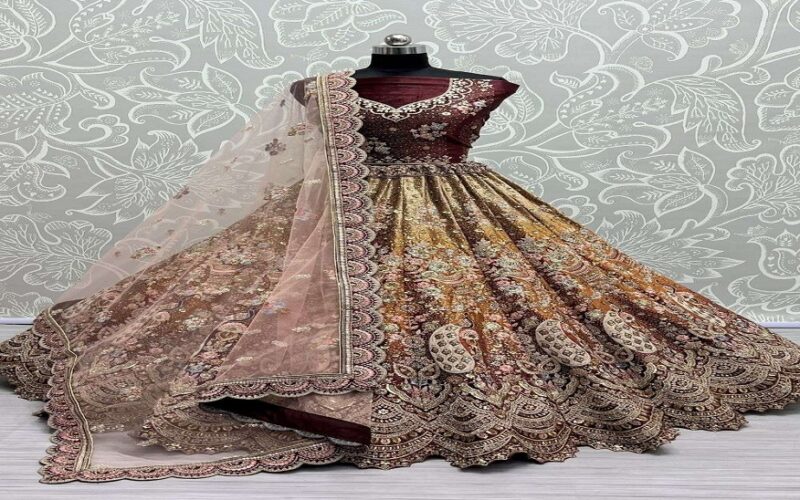The allure of a wedding lies not only in the sacred union of two souls but also in the vibrant tapestry of traditions and customs that accompany this joyous occasion. Among the myriad symbols of Indian bridal couture, the bridal lehenga stands out as an epitome of grace, elegance, and cultural richness. Let us embark on a fascinating journey through time, exploring the history and significance of bridal lehengas.
The Timeless Elegance of Bridal Lehengas: A Glimpse into the Past
To understand the roots of bridal lehengas, one must delve into the pages of history. The earliest mentions of lehengas date back to the Mughal era, a period characterized by opulence and artistic refinement. The Mughal empresses adorned themselves in intricately embroidered garments, often featuring voluminous skirts and elaborately crafted blouses, resembling the silhouette we now recognize as the modern bridal lehenga.
The Mughals, with their keen sense of aesthetics, brought about a fusion of Persian and Indian styles, resulting in the creation of regal ensembles. The lehenga, with its flowing drapes and intricate detailing, became a symbol of royal splendor. Over time, this attire transcended its aristocratic origins and found its way into the hearts of brides across different communities.
Evolution Through Eras: Bridal Lehengas in Different Cultural Contexts
As centuries passed, the bridal lehenga underwent a metamorphosis, adapting to the evolving tastes and preferences of diverse regions in India. Each community added its unique touch, infusing the garment with symbols and motifs that reflected its cultural identity. The Banarasi silk lehenga, the vibrant Rajasthani lehenga, and the ornate South Indian pattu langa are just a few examples of the myriad styles that emerged over time.
Pakistani suits for women often reflect a fusion of traditional and contemporary design elements, catering to a diverse range of preferences. Wedding suits for ladies are often purchased as ready-made outfits or as fabric pieces that can be tailored according to individual preferences.
the beginning of a new chapter in a woman’s life. The colors and embellishments chosen for the bridal lehenga often hold cultural meanings, signifying blessings, good fortune, and marital bliss.
Craftsmanship and Intricacy: The Making of a Bridal Lehenga
The creation of a bridal lehenga is a meticulous process that involves skilled artisans and master craftsmen. The fabric is carefully chosen, with silk, velvet, and brocade being popular choices for their luxurious feel and ability to hold intricate embellishments. The art of hand embroidery, zardozi, and threadwork is deployed to create mesmerizing patterns that tell a story of tradition and legacy.
The bridal lehenga is not just a piece of clothing; it is a work of art that reflects the rich heritage of Indian craftsmanship. Every stitch, every bead, and every thread narrates a tale of the dedication and skill poured into its creation. This blend of artistry and cultural symbolism makes the bridal lehenga a cherished heirloom, passed down through generations.
Symbolism Woven in Threads: Significance of Bridal Lehengas
Beyond its aesthetic appeal, the bridal lehenga is steeped in symbolism. The red hues, often chosen for bridal attire, symbolize love, passion, and fertility in many Indian cultures. The intricate embroidery and motifs tell stories of tradition, family, and the journey of the bride. The process of donning the bridal lehenga becomes a transformative ritual, symbolizing the bride’s transition from one phase of life to another.
Moreover, the bridal lehenga serves as a cultural identifier, reflecting the diverse tapestry of India. Each region’s distinctive style is a testament to the country’s unity in diversity, as brides embrace their roots through the choice of their bridal attire.
The Enduring Legacy: Bridal Lehengas in Contemporary Weddings
In the contemporary era, the bridal lehenga continues to evolve, adapting to modern fashion sensibilities while retaining its cultural essence. Designers experiment with colors, fabrics, and silhouettes, offering brides a plethora of choices that blend tradition with contemporary trends. From minimalist designs to extravagant creations, the bridal lehenga remains at the forefront of bridal fashion, embodying the timeless beauty of Indian weddings.
Conclusion
The bridal lehenga is more than a garment; it is a living chronicle of India’s cultural heritage. From its regal origins in the Mughal courts to its diverse avatars in different regions, the bridal lehenga has transcended time, weaving itself into the very fabric of Indian weddings. As brides continue to embrace this symbol of tradition, they not only adorn themselves in exquisite attire but also carry forward a legacy that celebrates the beauty of unity in diversity.

